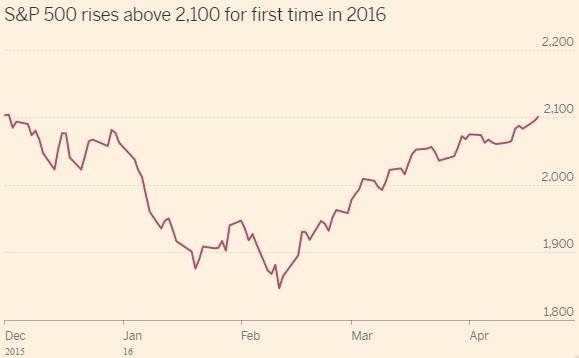Published by Debra Taylor, | April 25, 2016
Last week, the S&P 500 rose above the 2,100 level for the first time since December 2015. And the Dow Jones pushed above the 18,000 level, which has been the “talk of the town” on Wall Street. Opinions about the significance of rising above these levels are divided. Some believe there is great meaning tied to these levels because it may encourage investors to buy stocks or become slightly more bullish if this level is exceeded. While others feel that the Dow’s 18,000 level has no significance at all. No matter what, the levels are certainly nearing all-time highs.
If we look specifically at the S&P 2,100 level, we know that the market has met resistance here several times before. In fact, the S&P 500 has closed above the 2,100 level 95 times since December 2015. Moreover, on 56 of those 95 days, it also traded beneath 2,100 before closing above it. Basically, it seems there is no escaping that level, at least up until now.
Looking at the Dow, the numbers show that, since December 2014, the Dow has gained less than 30 points. That, however, does not mean it was calm during that time. The Dow has actually moved a total of 42,204 points (combined) since its first close above 18,000 in 2014 (source: LPL Financial Research, April 2016).
What does this mean for investors? We are certainly at an inflection point. The market needs a catalyst to break through its current levels, and the question is whether this current earnings season will provide enough positive news. Although revenue is estimated to decline year over year, the market seems to be shrugging off this news so far. Right now, we are cautious. Stay tuned…
If you have any questions about your investments or wish to make an appointment, please call our office.
Content in this material is for general information only and not intended to provide specific advice or recommendations for any individual. Past performance is not a guarantee of future results.
The Standard & Poor’s 500 Index is a capitalization weighted index of 500 stocks designed to measure performance of the broad domestic economy through changes in the aggregate market value of 500 stocks representing all major industries. The Dow Jones Industrial Average is comprised of 30 stocks that are major factors in their industries and widely held by individuals and institutional investors. The S&P 500 and the DJIA are unmanaged indices which cannot be invested into directly.



